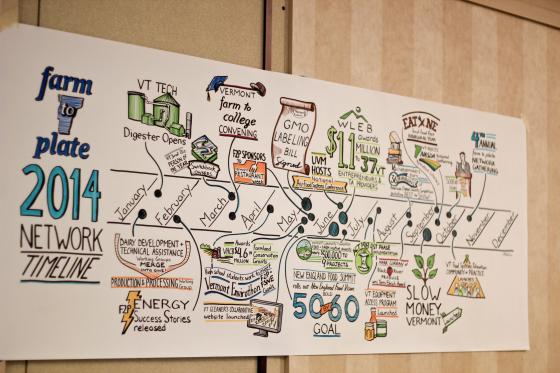Posted October 31, 2014 at 11:37am by
New job numbers, economic growth, and food justice conversations are focus at Vermont’s Farm to Plate Annual Gathering

Killington, VT – Every October, food system leaders and innovators who comprise the Vermont Farm to Plate Network convene to review the progress towards implementing the State of Vermont's Farm to Plate Strategic Plan and learn about the next set of challenges facing Vermont’s evolving food system. Approximately 300 individuals representing all facets of Vermont’s farm and food economy from farmers and food businesses to non-profit organizations, government agencies, and educational institutions attended this year’s Farm to Plate Annual Gathering at the Killington Grand Conference Center.
Last week, the Farm to Plate Network concluded its third year collectively working towards the statewide Farm to Plate goals to economic development and jobs in Vermont’s farm and food sector and improving access to healthy local food for all Vermonters.
An economic impact analysis conducted Nic Rockler (Kavet, Rockler & Associates) just prior to this year’s Gathering to better understand the bigger economic impact picture of the growth in our food system identified the following:
- Over the past 5 years, the food system has grown at a rate of 3% per year while the state’s overall growth rate has grown 1% per year.
- The total change in economic output over that 5 year period amounted $1.7 billion in new economic activity (gross state product output for Vermont's food system).
- Due to the multiplier effect of keeping dollars circulating in the state economy, the food system is actually responsible for adding 8,884 new direct, indirect and induced jobs. This means that for every job added in the food system an additional 1.28 jobs are added to the economy as a whole.
- And according to the US Census of Agriculture and the VT Department of Labor, there has been an increase of 625 new farms and food-related businesses created in the state over a similar time period.
Secretary of Agriculture Chuck Ross announced these numbers just prior to Governor Shumlin’s formal remarks at the Farm to Plate Gathering. “We have started something in Vermont that is truly innovative and a model for the nation. Good food, strong communities, healthy families -- that is what our Farm to Plate program is about,” the Governor concluded.
The goals of Vermont’s Farm to Plate Strategic Plan are being addressed by both the collective work taking place within the Farm to Plate Network structure and also by individual businesses, organizations, agencies, and institutions who make up the Farm to Plate Network. Progress towards the goals are tracked on the Getting to 2020 page of the Farm to Plate website (www.vtfarmtoplate.com/getting-to-2020) and are also reported to the Vermont Legislature each January.
“Over the past year, the Farm to Plate Network has experienced a transition from a research and development phase to accomplishing tangible projects,” says Erica Campbell, Farm to Plate program director. The Farm to Plate Network supported the launch of Slow Money VT and the Working Lands Enterprise Board used the Farm to Plate Strategic Plan to help inform its grant making to farms, food-related businesses and the non-profit technical assistance providers who support them. An independent grocery store assessment is now complete which identified gaps and next steps for getting local food into more grocery stores in Vermont. The Network continues to grow, engage, and provide the space for conversations – including with other New England states around the regional food vision to produce at least 50 percent of the food consumed by New Englanders by 2060.
“There is still much work to be done,” Campbell continues. “Even in Vermont, we are far too reliant on food grown and distributed outside of our region and decisions made outside of our control. This creates vulnerabilities for Vermont’s working landscape, the resilience of our farms and communities, and for environmental quality, public health, and food justice.”
Food equity and justice was given special consideration at this year’s Gathering. One in seven Vermonters are food insecure and struggle to meet one of their most basic needs. Network members focused on both the moral imperative to ensure that all Vermonters can benefit from the local food movement and the fact that overcoming food access barriers is good for food and farm businesses because it expands the market of consumers.
Additional topics that address the food system – how food is produced and distributed – were explored deeply at the Farm to Plate Gathering. Getting local food into retail stores, marketing the Vermont brand, financing the food system, the need to get more farmland under production, understanding Vermont's food consumer, farm viability, food system education, and how public health relates to our local food movement were all sessions where Network members shared, learned from one another, and identified gaps and potential next steps for action.
###
Vermont Farm to Plate is the statewide initiative legislatively directed to increase economic development and jobs in Vermont’s farm and food sector and improve access to healthy local food for all Vermonters. The ten year Farm to Plate Strategic Plan to strengthen the working landscape, build the resilience of farms and food enterprises, improve environmental quality, and increase healthy, local food access for all Vermonters is being implemented by the Farm to Plate Network—over 350 farm and food sector organizations from across the state. Farm to Plate is coordinated by the Vermont Sustainable Jobs Fund, a non-profit organization based in Montpelier, Vermont. Learn more about the plan, network, and how progress is being tracked at www.VTFarmtoPlate.com.
